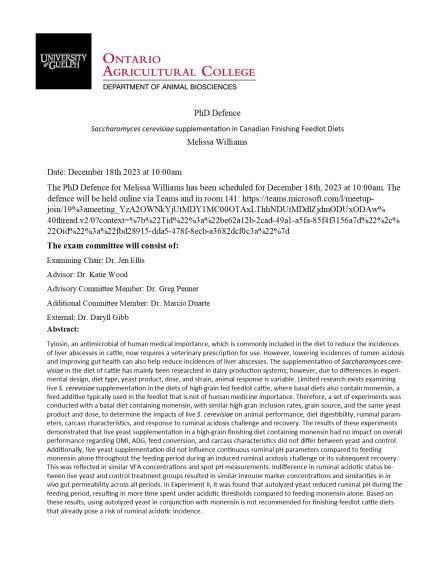Melissa Wiliams' PhD Defence
Date and Time
Location
Room 141 and Teams: https://teams.microsoft.com/l/meetup-join/19%3ameeting_YzA2OWNkYjUtMDY1MC00OTAxLThhNDUtMDdlZjdmODUxODAw%40thread.v2/0?context=%7b%22Tid%22%3a%22be62a12b-2cad-49a1-a5fa-85f4f3156a7d%22%2c%22Oid%22%3a%22fbd28915-dda5-478f-8ecb-a3682dcf0c3a%22%7d

Details
Saccharomyces cerevisiae supplementation in Canadian Finishing Feedlot Diets
Tylosin, an antimicrobial of human medical importance, which is commonly included in the diet to reduce the incidences of liver abscesses in cattle, now requires a veterinary prescription for use. However, lowering incidences of rumen acidosis and improving gut health can also help reduce incidences of liver abscesses. The supplementation of Saccharomyces cerevisiae in the diet of cattle has mainly been researched in dairy production systems; however, due to differences in experimental design, diet type, yeast product, dose, and strain, animal response is variable. Limited research exists examining live S. cerevisiae supplementation in the diets of high-grain fed feedlot cattle, where basal diets also contain monensin, a feed additive typically used in the feedlot that is not of human medicine importance. Therefore, a set of experiments was conducted with a basal diet containing monensin, with similar high-gran inclusion rates, grain source, and the same yeast product and dose, to determine the impacts of live S. cerevisiae on animal performance, diet digestibility, ruminal parameters, carcass characteristics, and response to ruminal acidosis challenge and recovery. The results of these experiments demonstrated that live yeast supplementation in a high-grain finishing diet containing monensin had no impact on overall performance regarding DMI, ADG, feed conversion, and carcass characteristics did not differ between yeast and control. Additionally, live yeast supplementation did not influence continuous ruminal pH parameters compared to feeding monensin alone throughout the feeding period during an induced ruminal acidosis challenge or its subsequent recovery. This was reflected in similar VFA concentrations and spot pH measurements. Indifference in ruminal acidotic status between live yeast and control treatment groups resulted in similar immune marker concentrations and similarities in in vivo gut permeability across all periods. In Experiment II, it was found that autolyzed yeast reduced ruminal pH during the feeding period, resulting in more time spent under acidotic thresholds compared to feeding monensin alone. Based on these results, using autolyzed yeast in conjunction with monensin is not recommended for finishing feedlot cattle diets that already pose a risk of ruminal acidotic incidence. In Experiment III, although differences were not observed for yeast treatment, the ruminal acidosis induction was successful, with the recovery of ruminal pH between 2-4 days post-induction, dependent on the parameter examined. Surprisingly, ruminal acidosis induction reduced circulating SAA levels from baseline, which may indicate a chronic immune response to the high-grain diet that was not fully adapted. Additionally, post-ruminal gut permeability measurements indicated an improvement between 5-15 days post-induction, although not different from baseline. This may indicate increased hindgut permeability despite insult by acidosis induction to the rumen. Differences in ruminal and post-ruminal gut permeability response were unexpected and require further examination to explain these results. Overall, the additional of live S. cerevisiae to a high-grain feedlot diet containing monensin does not have differing effects on animal performance, diet digestibility, carcass characteristics, ruminal pH parameters or, response to ruminal acidosis challenge regarding ruminal pH, VFA, or gut permeability compared to feeding monensin alone. It is recommended to examine microbial populations with this combination of additives, as well as to conduct experiments with and without monensin included in the basal diet to confirm possible interactions observed.